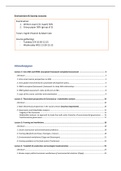Environment & Society Lectures
Examination:
1. Written exam (31 maart) 50%
2. Group paper 50% (group of 5)
Tuturs: Ingrid Visseren & Adam Calo
Course gatherings
- Tuesday CC4 10:30-12:15
- Wednesday WG1 13:30-15:15
Inhoudsopgave
Lecture 1: Intro E&S and IPBES conceptual framework and global assessment ................................................ 3
Literature ............................................................................................................................................................ 3
1: Intro social science perspectives on E&S ........................................................................................................ 3
2: Intro global environmental & sustainable development policy ...................................................................... 4
3: IPBES conceptual framework: framework to study E&S relationships ........................................................... 6
4: IPBES global assessment: state-of-the-art on E&S ......................................................................................... 8
5: Logic of the course: activities and examination ............................................................................................. 9
Lecture 2: Theoretical perspectives & Governance + stakeholder analysis ..................................................... 10
Literature .......................................................................................................................................................... 10
1: Main theoretical perspectives in the social sciences (muchos importante) ................................................. 10
2: Governance and stakeholder analysis: ......................................................................................................... 11
Tragedy of the Commons ............................................................................................................................ 11
Stakeholder analysis: an approach to study the multi-actor character of environmental governance ...... 15
Transformative governance ......................................................................................................................... 17
Lecture 3: Framing and worldviews ................................................................................................................ 18
Literature .......................................................................................................................................................... 18
1: Social construction (of environmental problems) ......................................................................................... 18
2: Framing (Benford and Snow, Hannigan, Cronon) ......................................................................................... 18
3: Environmental worldviews (Clapp and Dauvergne) ..................................................................................... 21
4: Framing problems in the food system (Tomlinson) ...................................................................................... 23
Lecture 4: Treadmill of production and ecological modernization .................................................................. 25
Literature .......................................................................................................................................................... 25
1: Review major political economic worldviews of environmental solutions (Clapp) ....................................... 25
, 2: Treadmill of production (T.O.P.) ................................................................................................................... 27
3: Ecological Modernization ............................................................................................................................. 30
Degrowth as an emerging alternative ......................................................................................................... 33
Lecture 5: Philosophy of science and social scientific perspectives ................................................................. 34
Literature .......................................................................................................................................................... 34
The Anthropocene: current perspective on Environment-Society relations (Steffen et al; Baskin; Bierman) ... 34
Philosophy of science (and social scientific perspectives) (Moon and Blackman) ............................................ 35
Info on exam ..................................................................................................................................................... 38
Lecture 6: Guest lecture ................................................................................................................................. 39
2
,Lecture 1: Intro E&S and IPBES conceptual framework and global
assessment
By Ingrid
Literature
1) Giddens, The Environment, chapter 5 (partim) from A. Giddens, Sociology, Polity Press,
Cambridge, 2008 (6th Edition), pp. 155-166.
2) J. Pretty et al., Introduction to Environment and Society, in J. Pretty et al., The SAGE
Handbook of Environment and Society, SAGE, Los Angeles, 2007, pp. 1-15.
3) Diaz, S. et al. 2015. The IPBES conceptual framework – connecting nature and people.
Current Opinion in Environmental Sustainability 14: 1-16.
4) Visseren-Hamakers, I.J., 2020. The 18th Sustainable Development Goal. Earth System
Governance 3: 100047.
1: Intro social science perspectives on E&S (also see today’s readings: Giddens and Pretty et al.)
2: Intro global environmental & sustainable development policy
3: IPBES conceptual framework: framework to study E&S relationships
4: IPBES global assessment: state-of-the-art on E&S
5: Logic of the course: activities and examination
1: Intro social science perspectives on E&S
Environment and society
- Society as a cause of & solution to environmental problems
- Environmental problems influence society
- But: society part of environment?
All social scientific disciplines study Environment & Society
- See Giddens and Pretty et. Al for overviews
Selection of perspectives/approaches/frameworks in this course
- IPBES conceptual framework
- Governance
- Stakeholder analysis
- Framing
- Worldviews
- Treadmill of production
- Ecological modernization
3
,2: Intro global environmental & sustainable development policy
The concept of sustainable development: different contributions
• Late 1980s: the Brundtland commission (WCED) in Our common future, report on request of
the UN, both UNDP and UNEP, Anticipating the 1992 Rio summit
• Defined as: ‘sustainable development is a development which. Meets the needs of the
present without compromising the ability of future generations to meet their own needs’.
Sustainable Development Goals (SDGs)
The 18th SDG (Visseren-Hamakers)
4
,The OXFAM – Kate Raworth approach
Planetary boundaries for ‘environmental ceiling’ (a safe space) is paralleled to ‘social foundations’ (=
a just space): the doughnut
The ecocentric, compassionate an just doughnut economy
5
, 3: IPBES conceptual framework: framework to study E&S relationships
• Intergovernmental Platform on Biodiversity & Ecosystem Services
• Inspired by IPCC, science-policy interface
• Discussions on IPBES started in 2007, after finalization of Millennium Ecosystem Assessment
(MA, 2005)
• 1st IPBES Plenary in 2013 in Bonn
• Over 130 Member States / secretariat in Bonn
• Global Assessment (GA) published in May 2019, in time for renewal Strategic Plan CBD and
its Aichi targets: Post-2020 Global Biodiversity Framework
• Regional assessments (feed into GA)
• Thematic assessments (pollinators, land degradation, pandemics, IAS, …)
• Upcoming assessments: nexus and transformative change
Arrows are where the action is happening.
The fabric of life on Earth is deteriorating fast worldwide: virtually all indicators of the global
state of nature are decreasing.
The biosphere and atmosphere, upon which humanity as a whole depends, have been
deeply reconfigured by people
- 75% of the land area is very significantly altered
- 66% of the ocean area is experiencing increasing cumulative impacts
- >85% of wetland area has been lost
6





